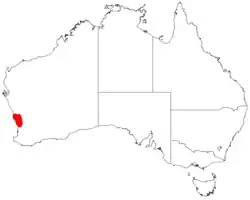Acacia cummingiana
| Acacia cummingiana | |
|---|---|
| Scientific classification | |
| Kingdom: | Plantae |
| Clade: | Tracheophytes |
| Clade: | Angiosperms |
| Clade: | Eudicots |
| Clade: | Rosids |
| Order: | Fabales |
| Family: | Fabaceae |
| Subfamily: | Caesalpinioideae |
| Clade: | Mimosoid clade |
| Genus: | Acacia |
| Species: | A. cummingiana
|
| Binomial name | |
| Acacia cummingiana | |

| |
| Occurrence data from AVH | |
| Synonyms[1] | |
|
Racosperma cummingianum (Maslin) Leslie PedleyPedley | |
Acacia cummingiana is a species of flowering plant in the family Fabaceae and is endemic to a small area in the south-west of Western Australia. It is a sprawling, straggly, rush-like shrub with striated branches, phyllodes reduced to thin, flattened scales, spherical heads of bright, light golden yellow flowers and shallowly curved, leathery to crusty pods.
Description
Acacia cummingiana is a sprawling, straggly, rush-like shrub or subshrub, that typically grows to a height of 30–50 cm (12–20 in) and has terete, striated branches. Its phyllodes are reduced to continuous, thin, horizontally flattened, narrowly oblong to narrowly triangular scaled 1.5–4 mm (0.059–0.157 in) long. The flowers are borne in spherical heads in one or two scale axils, on a peduncle 4–15 mm (0.16–0.59 in) long. Each head is about 8 mm (0.31 in) in diameter when dry, and has 8 to 12 loosely arranged, bright light golden flowers. Flowering occurs from May to June, sometimes to August, and the pods are stalked, 40–70 mm (1.6–2.8 in) long and 8–10 mm (0.31–0.39 in) wide, shallowly curved and leathery to crusty. The seeds are oblong to elliptic, about 5.5 mm (0.22 in) long with a conical aril on the end.[2][3][4][5][6]
Taxonomy
Acacia cummingiana was first formally described in 1995 by Bruce Maslin in the journal Nuytsia from specimens collected north-east of Dandaragan in 1979.[2][7] The specific epithet (cummingiana) honours Russell Cumming, in recognition of his contribution to the taxonomy of the genus Acacia.[3]
Distribution
This species of wattle is restricted to a small area between Watheroo National Park and Wannamal where it grows in sand or gravel in heath or low woodland in the Avon Wheatbelt, Geraldton Sandplains and Swan Coastal Plain bioregions of south-western Western Australia.[4]
Conservation status
Acacia cummingiana is listed as "Priority Three" by the Government of Western Australia, Department of Biodiversity, Conservation and Attractions,[6] meaning that it is poorly known and known from only a few locations but is not under imminent threat.[8]
See also
References
- ^ a b "Acacia cummingiana". Australian Plant Census. Retrieved 10 August 2025.
- ^ a b Maslin, Bruce R. (1995). "Acacia Miscellany 13. Taxonomy of some Western Australian phyllocladinous and aphyllodinous taxa (Leguminosae: Mimosoideae)". Nuytsia. 10 (2): 175–177. Retrieved 10 August 2025.
- ^ a b Maslin, Bruce R. Kodela, Phillip G. (ed.). "Acacia cummingiana". Flora of Australia. Australian Biological Resources Study, Department of Climate Change, Energy, the Environment and Water: Canberra. Retrieved 10 August 2025.
- ^ a b "Acacia cummingiana". World Wide Wattle. Western Australian Herbarium. Retrieved 23 August 2018.
- ^ "Acacia cummingiana". Australian Biological Resources Study. Retrieved 10 August 2025.
- ^ a b "Acacia cummingiana". FloraBase. Western Australian Government Department of Biodiversity, Conservation and Attractions.
- ^ "Acacia cummingiana". APNI. Retrieved 10 August 2025.
- ^ "Conservation codes for Western Australian Flora and Fauna" (PDF). Government of Western Australia Department of Parks and Wildlife. Retrieved 10 August 2025.
